1994 CHEVROLET CAVALIER ESP
[x] Cancel search: ESPPage 20 of 243
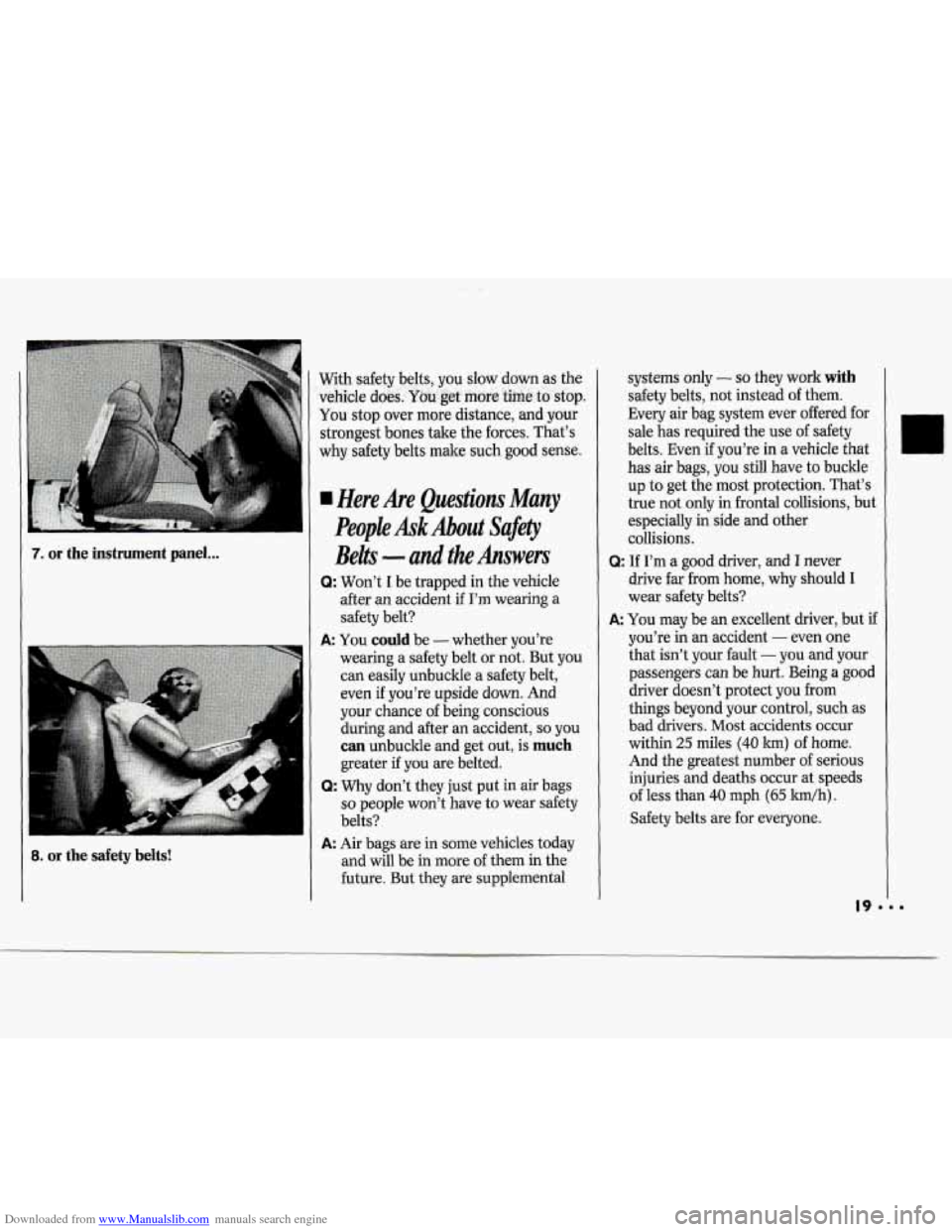
Downloaded from www.Manualslib.com manuals search engine 7. or the instrument panel ...
8. or the safety belts!
4
:”
With safety belts,. you slow down as the
You stop over more distance, and your
strongest bones take the forces. That’s
why safety belts make such good sense.
v6Kicle
d&~i;~&!&~ h&. ‘m&t&sQp,
HereAre Questions Many
People Ask About Safety
Belts
- and the Answers
Q: Won’t I be trapped in the vehicle
after
an accident if I’m wearing a
safety belt?
A: You could be -whether you’re
wearing a safety belt or not. But you
can easily unbuckle a safety belt,
even
if you’re upside down. And
your chance of being conscious
during and after an accident,
so you
can unbuckle and get out, is much
greater if you are belted.
Q: Why don’t they just put in air bags
so people won’t have to wear safety
belts?
A: Air bags are in some vehicles today
and will be
in more of them in the
future. But they are supplemental systems only
- so they work with
safety belts,
not instead of them.
Every
air bag system ever offered for
sale has required the use
of safety
belts. Even
if you’re in a vehicle that
has
air bags, you still have to buckle
up
to get the most protection. That’s
true not only
in frontal collisions, but
especially in side and other
collisions.
drive
far from home, why should I
wear safety belts?
A You may be an excellent driver, but if
you’re in an accident - even one
that isn’t your fault
- you and your
passengers can be
hurt. Being a good
driver doesn’t protect you from
things beyond your control, such as
bad drivers.
Most accidents occur
within
25 miles (40 km) of home.
And the greatest number
of serious
injuries and deaths occur at speeds
of less than
40 mph (65 lun/h).
Safety belts are for everyone.
Q: If I’m a good driver, and I never
I- I
Page 47 of 243
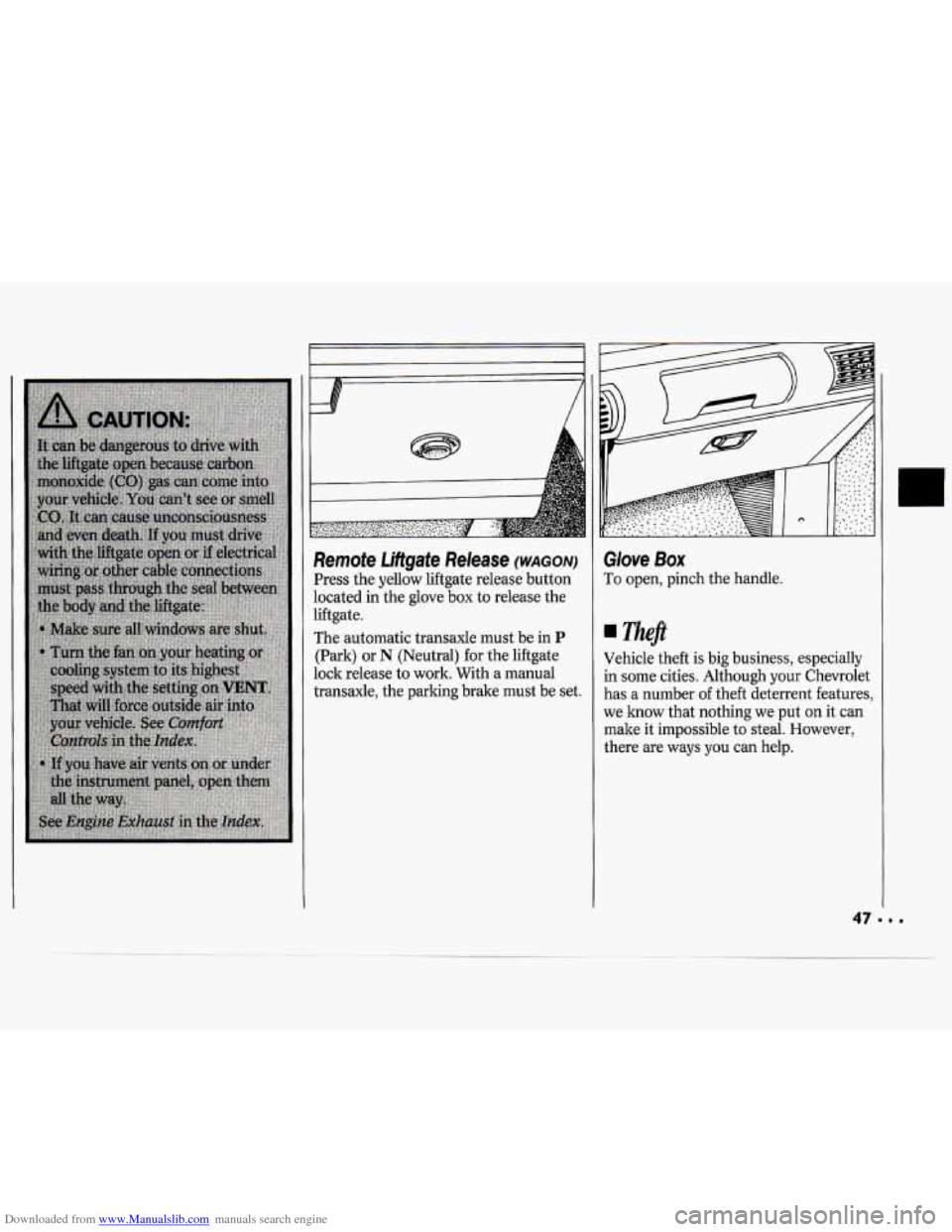
Downloaded from www.Manualslib.com manuals search engine Remote Liltgate Release (WAGON)
Press the yellow liftgate release button
located in the glove
box to release the
liftgate.
The automatic transaxle must be in
P
(Park) or N (Neutral) for the liftgate
lock release to work. With a manual
transaxle, the parking brake must be set.
Glove Box
To open, pinch the handle.
neft
Vehicle theft is big business, especially
in some cities. Although your Chevrolet
has a number
of theft deterrent features,
we know that nothing we put on it can
make it impossible to steal. However,
there are ways you can help.
Page 65 of 243

Downloaded from www.Manualslib.com manuals search engine Features & Controls
Operation of Lights
Although your vehicle’s lighting system
(headlights, parking lights, fog lamps,
side marker lights and taillights) meets
all applicable federal lighting
requirements, certain states and
provinces may apply their own lighting
regulations that may require special
attention before you operate these lights,
For example, some jurisdictions may
require that you operate your lower
beam lights with fog lamps at all times,
or that headlights be turned on
whenever you must use your windshield
wipers. In addition, most jurisdictions
prohibit driving solely with parking
lights, especially at dawn or dusk.
It is
recommended that you check with your
own state or provincial highway
authority for applicable lighting
regulations.
LLJ’ n
-
Turn Signal and Lane Change
Indicator
The turn signal has two upward (for
Right) and two downward (for Left)
positions. These positions allow you to
signal a turn or
a lane change.
To signal a turn, move the lever all the
way up or down. When the turn is
finished, the lever will return
automatically.
A green arrow on the instrument panel
will flash in the direction of the turn or
lane change.
I)
To signal a lane change, just raise or
lower the lever until the green arrow
starts to flash. Hold it there until you
complete your lane change. The lever
will return by itself when you release it.
As you signal a turn or a lane change, if
the arrows don’t flash but just stay on, a
signal bulb may be burned out and
other drivers won’t see your turn signal.
If a bulb is burned out, have your dealer
replace
it to help avoid an accident. If
the green arrows don’t go on at all
when
you signal a turn, check the fuse
(see the
Index under Fuses G Circuit
Breakers) and for burned-out bulbs.
Page 105 of 243
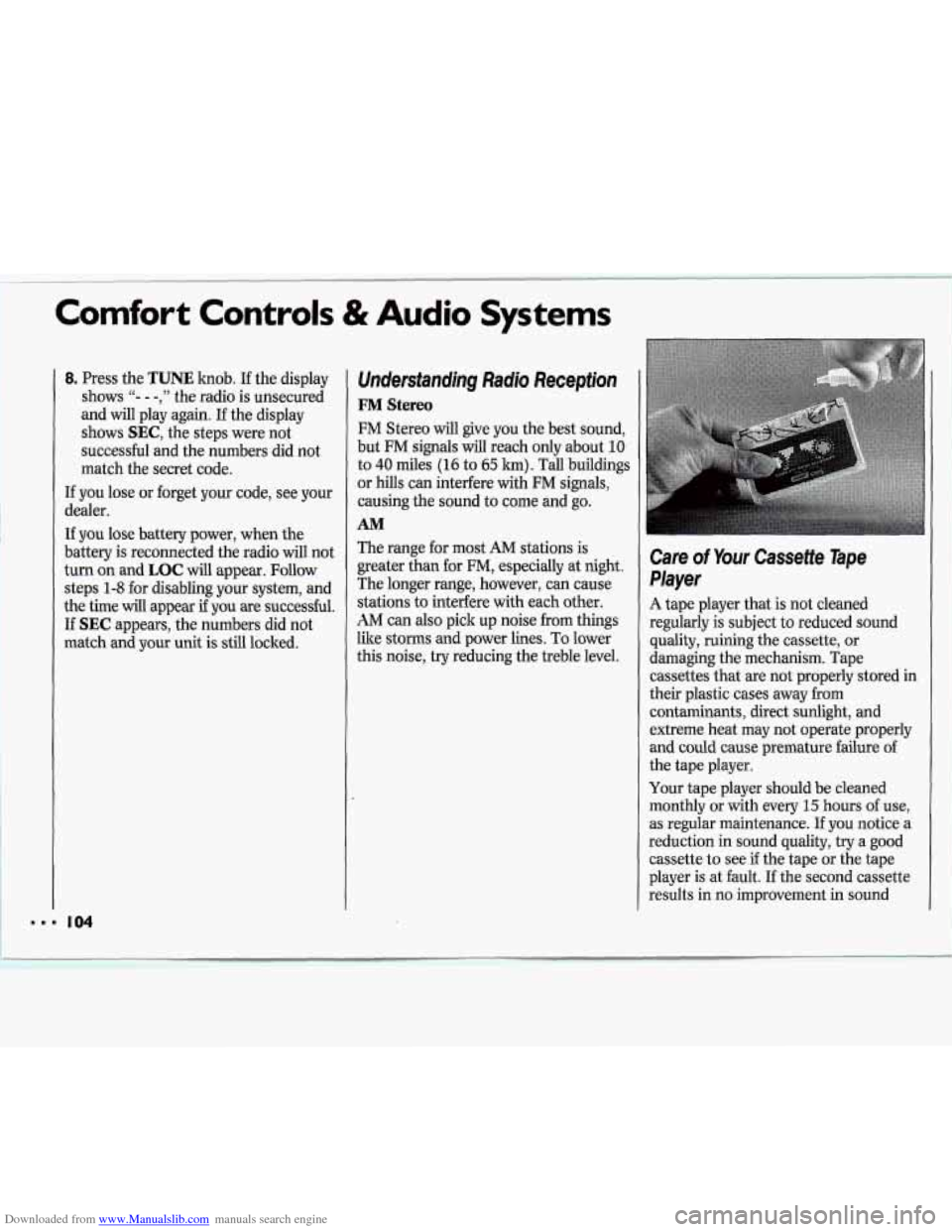
Downloaded from www.Manualslib.com manuals search engine Comfort Controls & Audio Systems
8. Press the TUNE knob. If the display
shows
"- - -," the radio is unsecured
and
will play again. If the display
shows
SEC, the steps were not
successful and the numbers did not
match the secret code.
If
you lose or forget your code, see your
dealer.
If you lose battery power, when the
battery is reconnected the radio will not
turn on and
IX)C will appear. Follow
steps
1-8 for disabling your system, and
the time will appear
if you are successful.
If
SEC appears, the numbers did not
match and
YOUK unit is still locked.
Understanding Radio Reception
FM Stereo
FM Stereo will give you the best sound,
but FM signals
will reach only about 10
to 40 miles (16 to 65 la). Tall buildings
or hills can interfere with FM signals,
causing the sound to come and go.
AM
The range for most AM stations is
greater than for
FM, especially at night.
The longer range, however,
can cause
stations to interfere with each other,
AM can also pick up noise from things
like storms and power lines. To lower
this noise,
try reducing the treble level.
Care of Your Cassette Tape
Player
A tape player that is not cleaned
regularly
is subject to reduced sound
quality, ruining the cassette, or
damaging the mechanism. Tape
cassettes that are not properly stored in
their plastic cases away from
contaminants, direct sunlight, and
extreme heat may not operate properly
and could cause premature failure of I'
the tape player.
Your tape player should be cleaned
monthly or with every
15 hours of use,
as regular maintenance. If you notice a ll
reduction in sound quality, try a good
cassette to see
if the tape or the tape
player is at fault. If the second cassette
results in no improvement in sound
Page 110 of 243
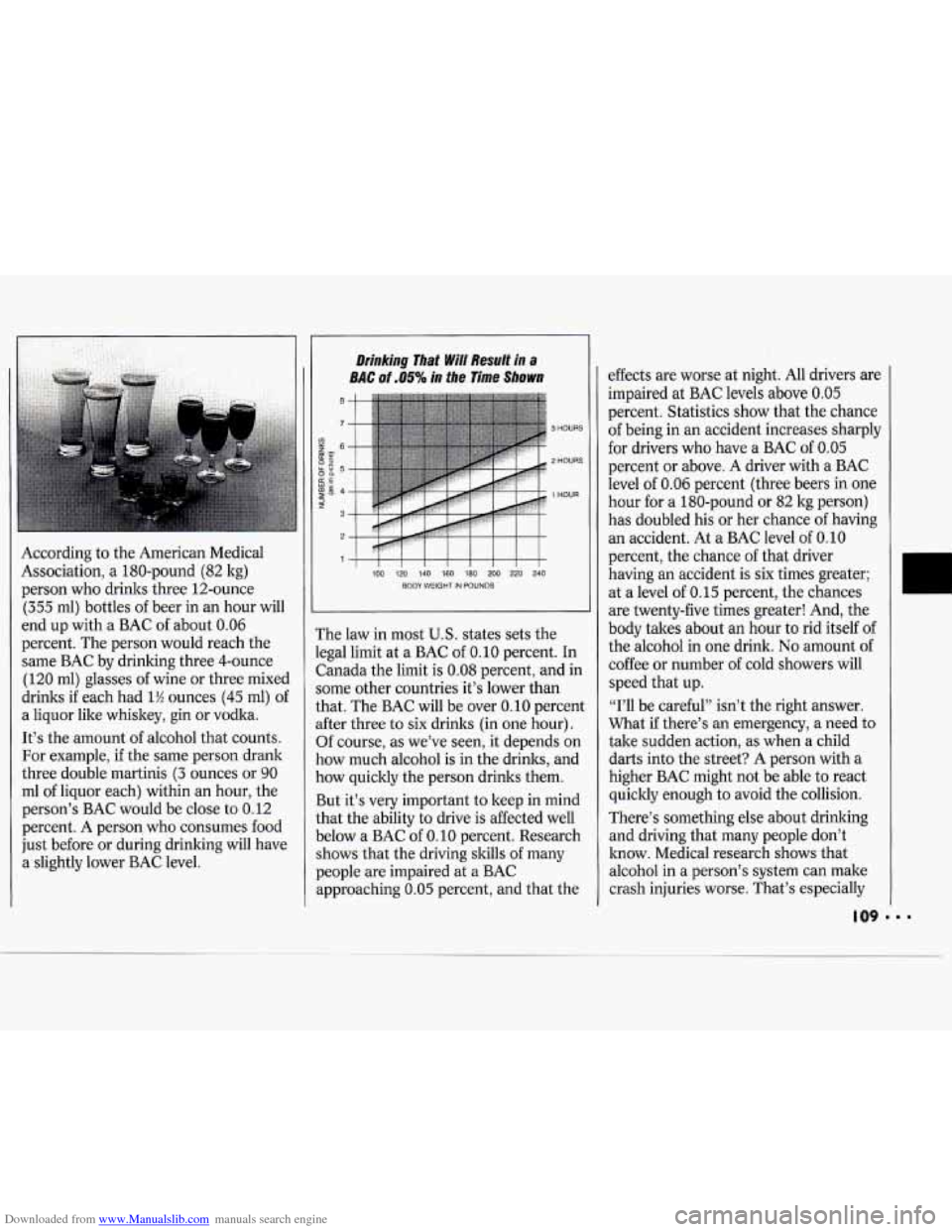
Downloaded from www.Manualslib.com manuals search engine According to the American Medical
Association, a 180-pound (82 kg)
person who drinks three 12-ounce
(355 ml) bottles of beer in an hour will
end up with a BAC
of about 0.06
percent. The person would reach the
same BAC by drinking three 4-ounce
(120 ml) glasses of wine or three mixed
drinks
if each had 1 H ounces (45 ml) of
a liquor like whiskey, gin or vodka.
It’s the amount
of alcohol that counts.
For example, if the same person drank
three double martinis
(3 ounces or 90
ml of liquor each) within an hour, the
person’s BAC would
be close to 0.12
percent. A person who consumes food
just before or during drinking will have
a slightly lower BAC level.
Drinking That WIN Resuit in a
BAC of -05% in the Time Shown
3 HOURS
2 HOURS
1 HOUR
100 120 140 160 180 200 220 240 BOQY WEIGHT IN POUNDS
rhe law in most U.S. states sets the
legal limit at a BAC of
0.10 percent. In
Canada the limit is
0.08 percent, and in
some other countries it’s lower than
that. The BAC will be over
0.10 percent
after three to six drinks (in one hour).
Of course, as we’ve seen,
it depends on
how much alcohol is in the drinks, and
how quickly the person drinks them.
But it’s very important to keep in mind
that the ability to drive is affected well
below
a BAC of 0.10 percent. Research
shows that the driving skills of many
people are impaired at a BAC
approaching
0.05 percent, and that the effects
are worse at night. All drivers are
impaired
at BAC levels above 0.05
percent. Statistics show that the chance
of being in an accident increases sharply
for drivers who have a BAC
of 0.05
percent or above. A driver with a BAC
level
of 0.06 percent (three beers in one
hour for a 180-pound or 82 kg person)
has doubled his or her chance
of having
an accident. At a BAC level of 0.10
percent, the chance of that driver
having an accident is six times greater;
at a level of 0.15 percent, the chances
are twenty-five times greater! And, the
body takes about an hour to rid itself
of
the alcohol in one drink. No amount of
coffee or number
of cold showers will
speed that up.
“I’ll be careful” isn’t the right answer.
What
if there’s an emergency, a need to
take sudden action, as when a child
darts into the street? A person with
a
higher BAC might not be able to react
quickly enough to avoid the collision.
There’s something else about drinking
and driving that many people don’t
know. Medical research shows that
alcohol in a person’s system can make
crash injuries worse. That’s especially
Page 116 of 243
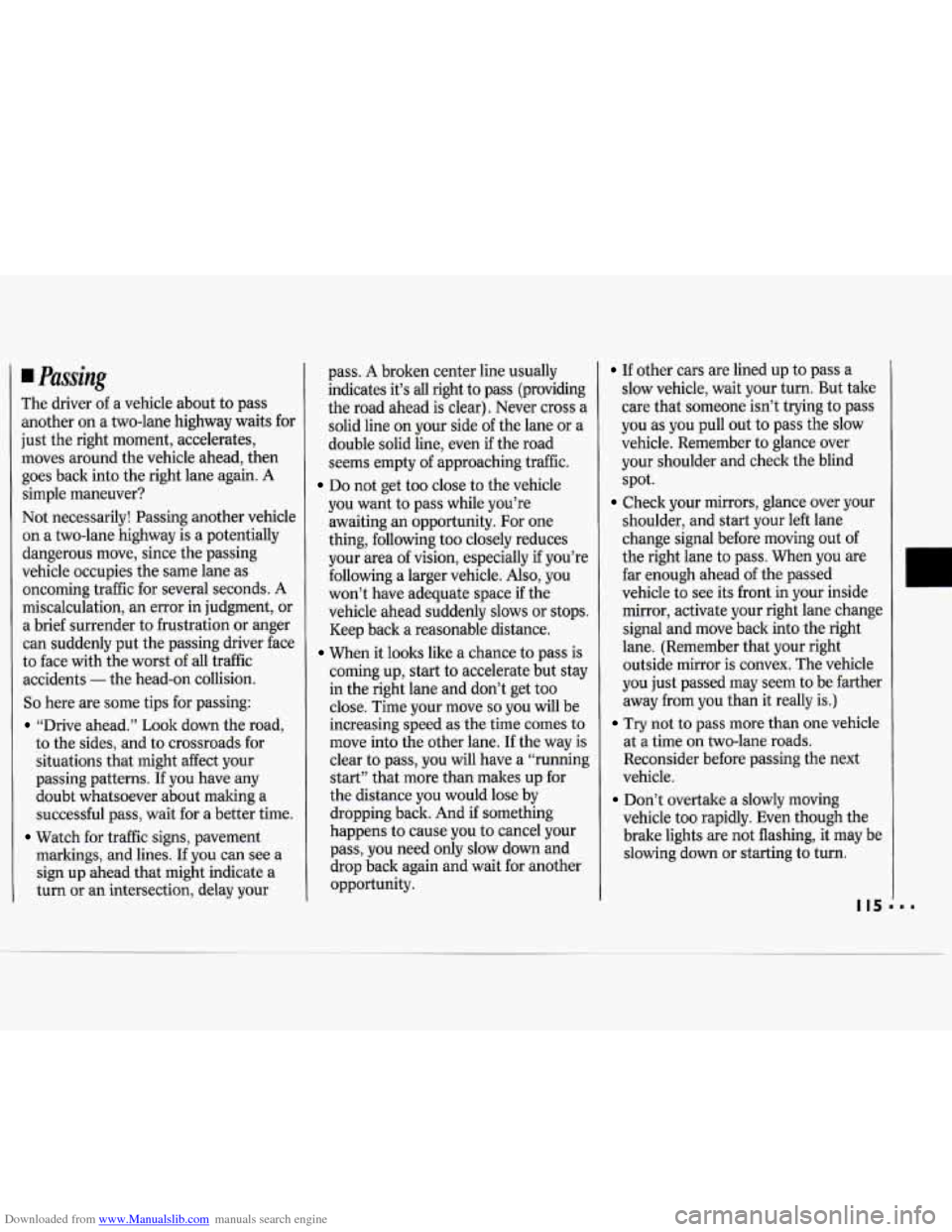
Downloaded from www.Manualslib.com manuals search engine Passing
The driver of a vehicle about to pass
another on a two-lane highway waits for
just the right moment, accelerates,
moves around the vehicle ahead, then
goes back into the right lane again. A
simple maneuver?
Not necessarily! Passing another vehicle
on a two-lane highway is a potentially
dangerous move, since the passing
vehicle occupies the same lane as
oncoming traffic for several seconds.
A
miscalculation, an error in judgment, or
a brief surrender to frustration or anger
can suddenly
put the passing driver face
to face with the worst of all traffic
accidents
- the head-on collision.
So here are some tips for passing:
“Drive ahead.” Look down the road,
to the sides, and
to crossroads for
situations that might affect your
passing patterns. If you have any
doubt whatsoever about making a
successful pass, wait for a better time.
Watch for traffic signs, pavement
markings, and lines. If you can see a
sign up ahead that might indicate a
turn or an intersection, delay your pass.
A broken
center line usually
indicates it’s
all right to pass (providing
the road ahead is clear). Never cross a
solid line on your side of the lane or
a
double solid line, even if the road
seems empty of approaching traffic.
Do not get too close to the vehicle
you want to pass while you’re
awaiting an opportunity. For one
thing, following too closely reduces
your area of vision, especially if you’re
following a larger vehicle. Also, you
won’t have adequate space if the
vehicle ahead suddenly slows or stops.
Keep back a reasonable distance.
When it looks like a chance to pass is
coming up, start to accelerate but stay
in the right lane and don’t get too
close. Time your move
so you will be
increasing speed as the time comes to
move into the other lane.
If the way is
clear to pass,
you will have a “running
start” that more than makes up for
the distance you would lose by
dropping back. And if something
happens to cause you to cancel your
pass, you need only slow down and
drop back again and wait for another
opportunity.
If other cars are lined up to pass a
slow vehicle, wait your turn. But take
care that someone isn’t trying to pass
you as you pull out to pass the slow
vehicle. Remember to glance over
your shoulder and check the blind
spot.
Check your mirrors, glance over your
shoulder, and start your left lane
change signal before moving out of
the right lane to pass. When you are
far enough ahead of the passed
vehicle to see its front in your inside
mirror, activate your right lane change signal and move back into the right
lane. (Remember that your right
outside mirror is convex. The vehicle
you just passed may seem to be farther
away from you than
it really is.)
Try not to pass more than one vehicle
at a time on two-lane roads.
Reconsider before passing the next
vehicle.
vehicle too rapidly. Even though the
brake lights are not flashing, it may be
slowing down or starting to turn.
Don’t overtake a slowly moving
Page 117 of 243
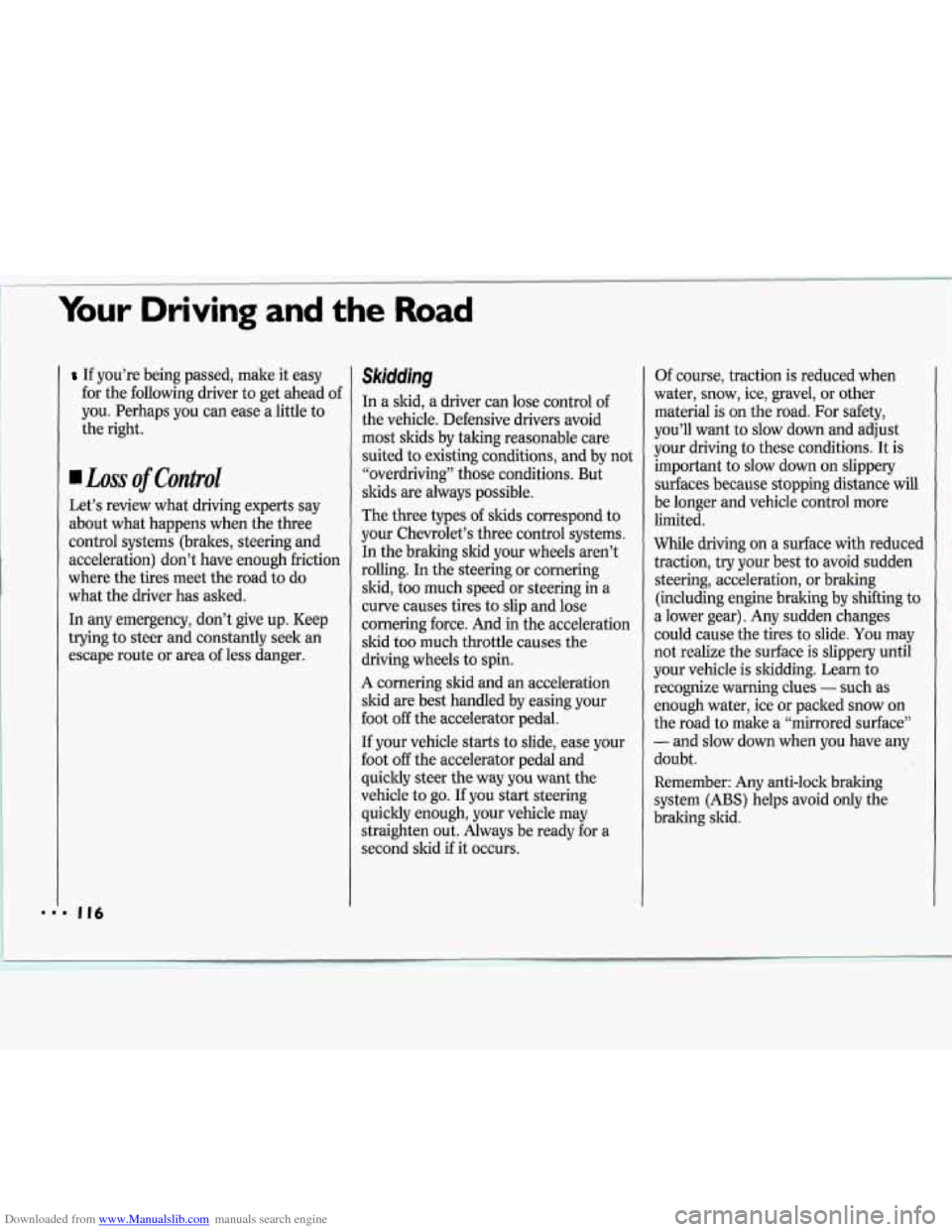
Downloaded from www.Manualslib.com manuals search engine Your Driving and the Road
If you’re being passed, make it easy
for the following driver to get ahead of
you. Perhaps you can ease a little to
the right.
Loss of Control
Let’s review what driving experts say
about what happens when the three
control systems (brakes, steering and
acceleration) don’t have enough friction
where the tires meet the road to do
what the driver has asked.
In any emergency, don’t give up. Keep
trying to steer and constantly seek an
escape route or area
of less danger.
Skidding
In a skid, a driver can lose control of
the vehicle. Defensive drivers avoid
most skids by taking reasonable care
suited
to existing conditions, and by not
“overdriving” those conditions. But
skids are always possible.
The three types of skids correspond to
your Chevrolet’s three control systems.
In the braking skid your wheels aren’t
rolling.
In the steering or cornering
skid, too much speed or steering in a
curve causes tires to slip and lose
cornering force. And in the acceleration
skid too much throttle causes the
driving wheels to spin.
A cornering skid and an acceleration
skid are best handled by easing your
foot
off the accelerator pedal.
If your vehicle starts to slide, ease your
foot
off the accelerator pedal and
quickly steer the way
you want the
vehicle to go.
If you start steering
quickly enough, your vehicle may
straighten out. Always be ready for a
second skid
if it occurs. Of
course, traction is reduced when
water, snow, ice, gravel, or other
material is
on the road. For safety,
you’ll want to slow down and adjust
your driving to these conditions. It is
important to slow down on slippery
surfaces because stopping distance will
be longer and vehicle control more limited.
While driving
on a surface with reduced
traction,
try your best to avoid sudden
steering, acceleration, or braking (including engine braking by shifting to
a lower gear). Any sudden changes
could cause the tires to slide. You may
not realize the surface is slippery until
your vehicle is skidding. Learn
to
recognize warning clues - such as
enough water, ice or packed snow on
the road to make a “mirrored surface”
- and slow down when you have any
doubt.
Remember: Any anti-lock braking
system (ABS) helps avoid only the
braking slid.
Page 118 of 243
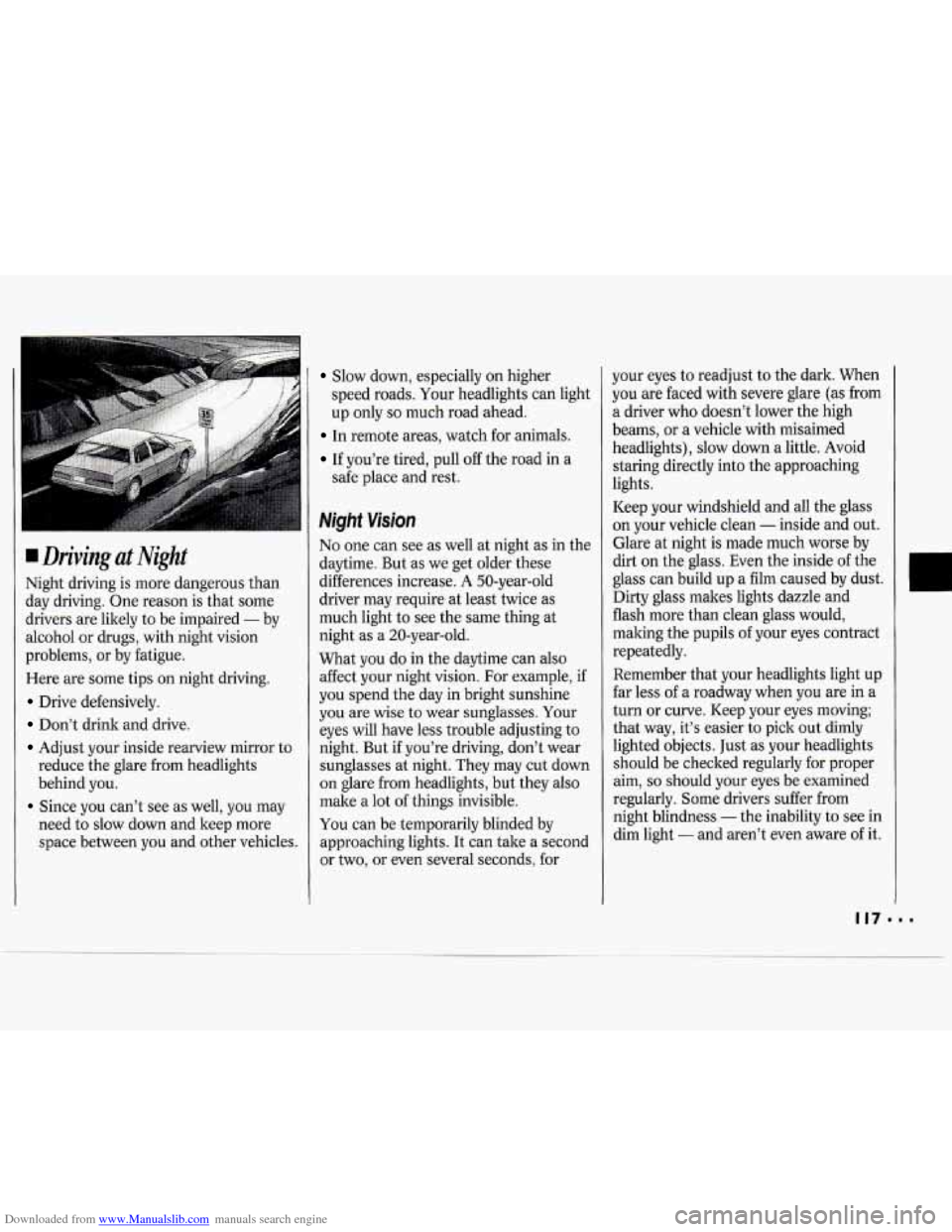
Downloaded from www.Manualslib.com manuals search engine Driving at Night
Night driving is more dangerous than
day driving. One reason is that some
drivers are likely to be impaired
- by
alcohol or drugs, with night vision
problems, or by fatigue.
Here are some tips on night driving.
Drive defensively.
Don’t drink and drive.
Adjust your inside rearview mirror to
reduce the glare from headlights
behind you.
Since you can’t see as well, you may
need to slow down and keep more
space between you and other vehicles.
Slow down, especially on higher
speed roads. Your headlights can light
up only
so much road ahead.
In remote areas, watch for animals.
If you’re tired, pull off the road in a
safe place and rest.
Night Vision
No one can see as well at night as in the
daytime. But as we get older these
differences increase.
A 50-year-old
driver may require at least twice as
much light to see the same thing at
night as a 20-year-old.
What you do in the daytime can also
affect your night vision. For example, if
you spend the day in bright sunshine
you are wise to wear sunglasses. Your
eyes will have less trouble adjusting to
night. But if you’re driving, don’t wear
sunglasses at night. They may cut down
on glare from headlights, but they also
make a lot
of things invisible.
You can be temporarily blinded by
approaching lights. It can take a second
or two, or even several seconds, for your eyes
to readjust to the dark. When
you are faced with severe glare (as from
a driver who doesn’t lower the high
beams, or a vehicle with misaimed
headlights), slow down
a little. Avoid
staring directly into the approaching
lights.
Keep your windshield and all the glass
on your vehicle clean - inside and out.
Glare at night is made much worse by
dirt on the glass. Even the inside of the
glass can build up a film caused by dust.
Dirty glass makes lights dazzle and
flash more than clean glass would,
malting the pupils of your eyes contract
repeatedly.
Remember that your headlights light up
far less of a roadway when you are in a
turn or curve. Keep your eyes moving;
that way, it’s easier to pick out dimly
lighted objects. Just as your headlights
should be checked regularly for proper
aim,
so should your eyes be examined
regularly. Some drivers suffer from
night blindness
- the inability to see in
dim light
- and aren’t even aware of it.
7